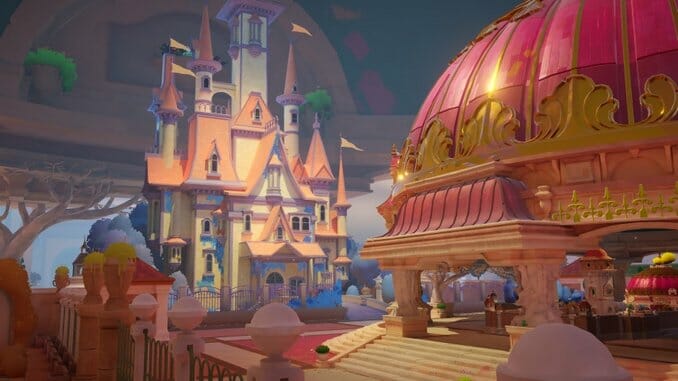Maquette Has More Brains than Heart

Relationships are hard. Writing them is hard, too. Maquette stands as proof: Annapurna’s smart, well-appointed puzzler puts forth a variety of sneakily challenging situations and scenarios, all in service of a deflating story about the collapse of a nondescript romance. You’ll need to enter this one with a committed love of puzzles, because the narrative engine that’s intended to drive you forward is a nonstarter.
At its heart is a striking central mechanic. You find yourself inside a dreamy pavilion that branches out into four distinct locations, almost like the hub of a theme park, but with buildings and scenic landscapes that feel unreal or half-remembered. At the very center is a dome, and within the dome is a smaller version of your surroundings. And within that smaller version is another dome—with another smaller copy of your world. Anything placed inside one dome is replicated in the other, at the appropriate scale; so a normal key in your human-sized realm would appear very small within the miniature world inside the dome. If you place that human-sized key inside that smaller world, though, a much larger key will now appear in the same spot within the regular-sized level. So a house key can become big enough to use as a bridge when needed, for example. You’ll use this technique to manipulate the size and scope of objects in order to solve various environmental puzzles and explore your surroundings.
There’s a dreamlike quality to the spaces you’ll explore, and when combined with the often abstruse solutions, it all recalls the surreal world of Myst. Maquette doesn’t rely solely on mystery, though. The reason everything around you feels vague and amorphous is because you’re exploring somebody’s memories, and particularly their memories of a crucial but ill-fated relationship.

Michael and Kenzie are a typical couple. They meet, they hang out, they grow close. Eventually they think they’re in love. Inevitably—painfully—they realize they’re not in love. You eavesdrop on pivotal moments in their lives together as you solve puzzles, the two represented on screen as hand-drawn birds that gradually come together and then fly apart. In between these short reveries you’ll occasionally see words appear on walls and buildings, sharing elliptic thoughts from one of the two lovers; these act as guideposts, pointing you towards your next puzzle.
These glimpses of Michael and Kenzie’s relationship are positioned as a kind of reward. You unlock them when you complete a puzzle and at the end of each chapter. They’re not very rewarding, though, because there’s not much to them. Propping up Maquette’s puzzles is a banal relationship drama that never comes together, featuring two underdrawn and unlikable characters who never quite earn our attention. The player essentially shifts through the shards of their time together, with these impermanent buildings and the puzzles within serving as obvious metaphors for the withering of their love.
